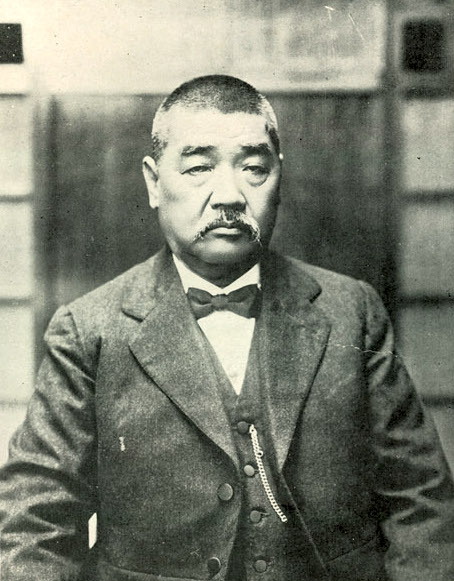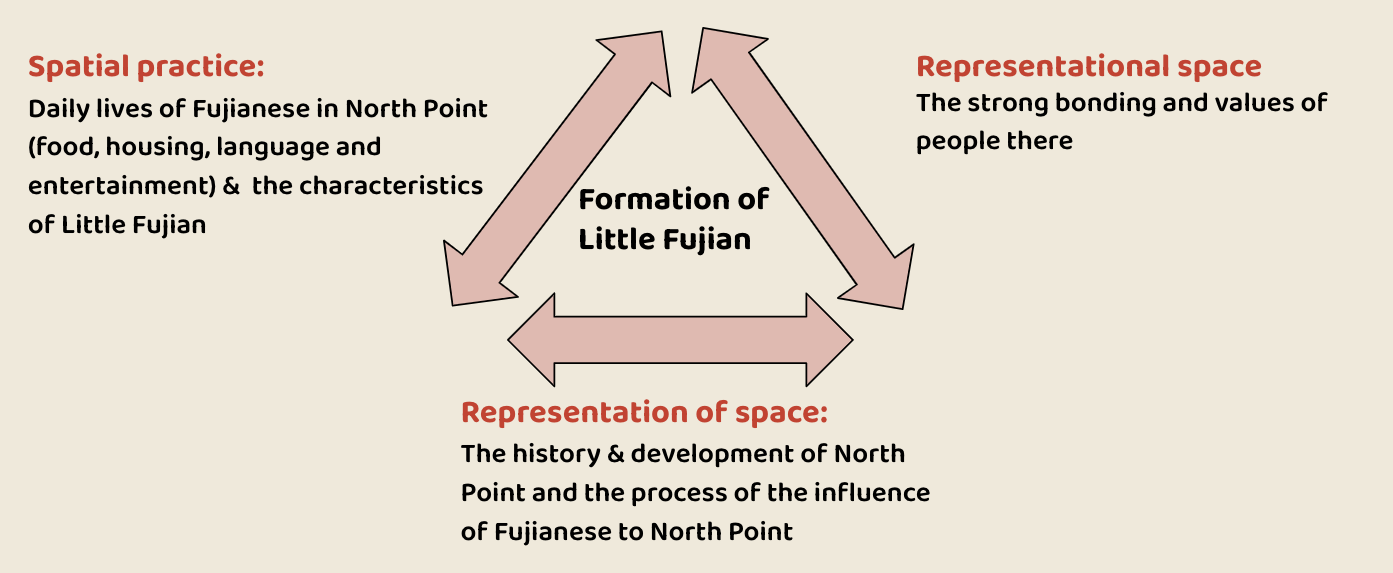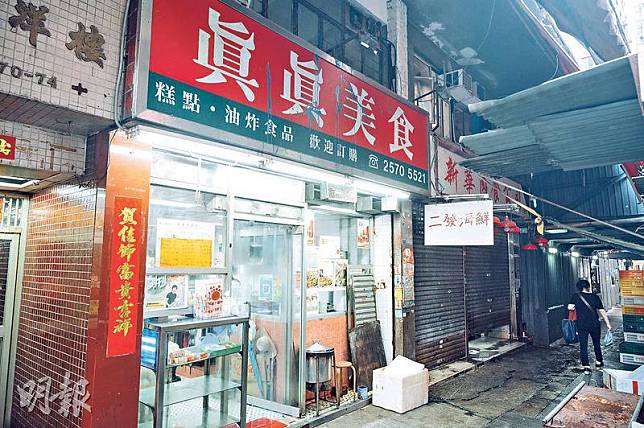A Study of Fujianese cultures evolving through lifestyles in North Point

Figure 1. Chun Yeung Street in North Point
(Source: Chan,2019)
1. Introduction
Fujianese is one of the largest populations in Hong Kong. There are more than 1 million Fujian immigrants in Hong Kong and more than ⅓ of them are living in North Point (Chang, 2014). North Point is also named as “Little Fujian '' as most of the Fujianese immigrants have gathered here since the 1960s and it forms a cultural community for Fujian people in Hong Kong. In addition, Chun Yeung Street is the most representative place in North Point, and it is welcomed by the local Fujianese as Fujian traditional food and stores can be easily found. Our projects aim to discover how the “Little Fujian” was formed with the aid of Henri Lefebvre’s theory of The Production of Space. Meanwhile, we try to investigate how important Little Fujian is and affect local Fujianese’s sense of place.
2. Cultural Geographical Perspective in Use
When it comes to the formation of Little Fujian, the theory of The Production of Space proposed by Henri Lefebvre could be applied for analysis. “Space is a product of society”, that is, space is constructed, operated, and practiced by social relations in order to manifest its existence. (Niehoff, 2020) Space should be formed by the continuous production and reproduction of human beings as collective subjects. (Pred, 1981) In order words, human participation endows with the existence of space and only with human participation does space produce meaning.
The Production of Space could be regarded as 3 dimensions to analyze, including spatial practice, representations of space and representational space.
Firstly, spatial practice refers to how we utilize our senses to perceive the world by being in the world. (Lefebvre, 1974) The process of mastering and occupying space produces the space slowly and firmly. Secondly, representations of space mean the dominant space in every society which refers to how we understand space through our understanding and ideology and certain ways of presenting space, such as maps. (Lefebvre, 1974) Thirdly, representational space is defined as a set of symbolism, which reflects the synergies and similarities between the natural, spiritual and social realities of the space. (Lefebvre, 1974) The space is produced under the mutual influence of these three dimensions.
|
|
Definitions |
Examples |
|
Spatial Practice |
How we utilize our senses to perceive the world by being the world |
Daily lives or activities |
|
Representations of space |
How we understand space through our understanding and ideology |
Map, historical development |
|
Representational space |
How symbolism reflects the synergies and similarities between the natural, spiritual and social realities of the space |
Resident’s values and attitudes towards the place |
Figure 2. Three dimensions of “The Production of Space”
(Source: Lefebvre, 1991)
These three dimensions are mutually influenced to produce space and the following figure shows how the Little Fujian is formed:

Figure 3. Conceptual framework of the production of space and its applications
(Source: from authors)
According to Soja, he continues and consolidates the discussion of representational space in the theory of the production of space. He suggests that the third space is a combination of physical and psychological quadrants, as well as time and users. It focuses more on how the space integrates entities, senses, emotions, and experiences. In short, there are various "relationships" with memory. (Soja, 1996) Through this integration, we will also use the theory of Sense of place to investigate further the connections of the individuals with the places. We will use the following components (Figure 4.) to discuss how local residents create bonding and connections with Little Fujian, and also the sense of “being homes” in North Point.

Figure 4. Components of sense of place
(Source: Brown et al., 2015; Mulvaney, 2020; Ng et al., 2021; Tester et al., 2011)
3. Empirical Analysis
3.1.1 Spatial practice of Little Fujian
In North Point, especially in the area of Chun Yeung Street, where all kinds of Fujian-style snacks and local products could be found, for example blood sausage soup, BBQ pork rice dumplings, Chinese meat rolls (Ngoh Hiang) and so on. Besides, housing is a part of daily life. According to the population census conducted in 1971, about 18% of the population in North Point was Fujianese, which is five times of the average of 3% for all districts in Hong Kong. (Chan, 2020) Many of them mainly live in old buildings there, such as City Mansion. Also, Hokkien is widely used in North Point. According to the language map carried out by The University of Hong Kong, about 9% of the population in North Point can speak Hokkien. Furthermore, entertainment in Little Fujian is also one of the proofs of spatial space. Most Fujianese believe in Buddhism, so many temples were built inside the old buildings in North Point by Fujianese or Fujian organizations. Some Fujian immigrants even brought the shrines from their hometowns to Hong Kong and put them in some religious associations or temples there for worship. (Chang, 2014) Fujianese must go to chant scriptures and have a vegetarian meal on the first, eighth and fifteenth day of every month or on the day of sacred birth. (Lam, 2016) Another main activity there is usually in Fujian associations, where many older Fujianese generations like to play Mahjong there in their spare time. (Chang, 2014) From the daily lives of Fujianese in North Point, including the Hokkien cuisine, the densely populated North Point buildings in Fujian, the popularity of Hokkien dialect in North Point, and the establishment of Fujian temples and Fujian associations are all the evidence of spatial practice.

Figure 5. Fujianese cuisine
(Source: from authors)
3.1.2 Representations of space of Little Fujian
In the 18th century, the increased population caused the development of Causeway Bay and North Point in the early period of the port opening of Hong Kong. The development of North Point has led to the relocation of Fujianese businessmen who moved there. Moreover, the history and development of North Point is evidence of representations of space. In 1917, the Fukien Chamber of Commerce was established, and it set up the first school specially for Fujianese in North Point since most of the Fujianese immigrants lived in North Point and most of them did not know Cantonese. Three years later, a key Fujianese businessman who was named Guo Chun Yeung, reclaimed land in North Point and he gave up on his original plan of building a sugar factory. The Hong Kong government therefore named the streets Chun Yeung Street and Tong Shui Road respectively in North Point. In 1948, he built 40 connected houses there and most of the residents were Fujianese immigrants. From the 1950s to 1960s, many Filipinos Chinese and Indonesian Chinese returned and moved to Hong Kong because of some political reasons.

Figure 6. Photo of Guo Chun Yeung
(Source: Wikipedia, 2022)
3.1.3 Representational space of Little Fujian
The values of residents and shopkeepers in Little Fujian demonstrate the representational space. North Point is a small Fujianese community in Hong Kong. (Guldin, 1977) Fujianese in North Point believe that they can take care of each other as neighbors, especially for newcomers/elderlies encounter language barriers. Furthermore, one of our interviewees is a Fujianese shopkeeper, Mrs. Leung claimed that “Cantonese people did not like our food and it was just for Fujianese.” In fact, many of the shopkeepers aim to provide ‘nostalgic food’ for Fujianese living in Hong Kong when Fujianese in Hong Kong are homesick. It thus shows the positive attitudes between them there.
3.1.4 The Production of Space and the formation of Little Fujian
Firstly, from the daily lives of Fujianese in North Point, including food, language, the Hokkien cuisine and so on are all the evidence of spatial practice. Secondly, representation of space includes the history and development of North Point. Thirdly, the strong bonding and values of people there demonstrates the representational space. The mutual influence of these three concepts makes the space meaningful and cause the formation of a small community there, that is Little Fujian.

Figure 7. Spatial triad and formation of Little Fujian
(Source from authors)
As the relationship between North Point and Little Fujian is far-reaching and the bonding between people is strong. Fujianese there regard this as their second home. In order to further investigate the feelings and values of people towards Little Fujian, it brings us to the next section via analyzing with another concept.
3.2 Sense of place in Little Fujian
Little Fujian is important for Fujianese immigrants in Hong Kong. As most of the Fujianese may face language barriers when they arrive in Hong Kong, the Little Fujian can help them to adapt to the living environment as the gathering of Fujianese there can help them to cooperate and help each other to tackle the difficulties of living. At the same time, there are also abundant jobs available in North Point, especially Chun Yeung Street, as most of the shops and restaurants were operated by Fujianese owners, they were more willing to recruit Fujianese people. Meanwhile, Little Fujian also provides opportunities for them to sell native Fujian cuisines and products, which can attract numerous Fujianese customers. WIth the job opportunities and the corporations among residents, Little Fujian can achieve a high place of dependence on local Fujianese residents.
Apart from that, strong bonding and connections with the place were also built in North Point. A lot of clan associations like Fujian Province Association is operated there to provide services for Fujianese people, such as Fujian opera, mahjong etc. People will gather to meet each other’s in the association, and it enhances strong social interactions among Fujianese locally. As a result, most of the residents have already built close bonding with the place from childhood to adulthood. Although they will move out of North Point one day, they will never forget their roots have served there (Chang, 2014). Therefore, a strong place identity is also built and the Fujianese people will recognize themselves as a “North Point” person.
“Little Fujian” is special for local Fujianese as it can give them a sense of being “home”. Most of the shop owners in Chun Yeung Street are Fujianese, so it is common to hear the neighbors talking in Hokkien on the street, it makes them feel more familiar with the environment and feel like coming back to home. During our visit, we also observed that the customers would use Hokkien language in their conversations, which shows a close relationship among the residents. Some important memories can also be created there, such as Fujianses immigrants can enjoy the Fujian folk food in the Fujianese restaurants located at Chung Yuen Street. In short, the Fujianese will recognize North Point to be the representative place for them to gather and they will come to try the most authentic Fujiansese cuisine, achieving a high place attachment in North Point.

Figure 8. Fujianese restaurant in Chun Yeung Street (真真美食店)
(Source: Ming Pao,2021)
4. Conclusion
To conclude, the formation of Little Fujian is analyzed through the production of space with three dimensions. We analyze the characteristics of Little Fujian through spatial practice, in which the authentic Fujianese food, housings that are full of Fujianese, Hokkien as common language, and special Fujianese activities there. Next, we explore the geographical change in North Point and the development history of Little Fujian that is deeply and permanently influenced by Fujianese via representations of space, followed by investigating the positive attitudes of people towards the neighbors and place thereby representational space. Little Fujian is eventually formed under the mutual influence of these three dimensions. To further understand the connection of people there with the place, the sense of place is applied for analysis. We evaluate the bonding between residents and Little Fujian through place dependence, sense of belongings for the place of people there by place attachment and closeness with the place of people via place attachment. It is observed that most of the people there connect with each other and the bonding between them and North Point is very strong that they recognize North Point as their home.
Reference
Alrobaee, T. R., & Al-Kinani, A. S. (2019). Place dependence as the physical environment role function in the place attachment. IOP Conference Series: Materials Science and Engineering, 698(3), 033014. https://doi.org/10.1088/1757-899x/698/3/033014
Anonymous. (2020). 從「小上海」到「小福建」. 大公報. Retrieved November 12, 2022, from http://www.takungpao.com.hk/news/232109/2020/1010/506737.html
Brown, G., Raymond, C. M., & Corcoran, J. (2015). Mapping and measuring place attachment. Applied Geography, 57, 42–53. https://doi.org/10.1016/j.apgeog.2014.12.011
Chang, S. (2014). 'Little Fujian' lives up to its past. China Daily Asia. Retrieved November 15, 2022, from https://www.chinadailyasia.com/hknews/2014-06/20/content_15142781.html
Guldin, G. E. (1977). “LITTLE FUJIAN (FUKIEN)”: SUB-NEIGHBORHOOD AND COMMUNITY IN NORTH POINT, HONG KONG. Journal of the Hong Kong Branch of the Royal Asiatic Society, 17, 112–129. http://www.jstor.org/stable/23889582
Lefebvre, H. (1991). The production of space. Oxford: Blackwell.
Lestari, W. M., & Sumabrata, J. (2018). The influencing factors on place attachment in neighborhood of Kampung Melayu. IOP Conference Series: Earth and Environmental Science, 126, 012190. https://doi.org/10.1088/1755-1315/126/1/012190
Mulvaney, K. K., Merrill, N. H., & Mazzotta, M. J. (2020). Sense of place and water quality: Applying sense of place metrics to better understand community impacts of changes in water quality. Water Quality - Science, Assessments and Policy. https://doi.org/10.5772/intechopen.91480
Ng, M. K., Yeung, T. C., Kwan, M.-P., Tieben, H., Lau, T. Y., Zhu, J., & Xu, Y. (2021). Place qualities, sense of place and subjective well-being: A study of two typical urban neighbourhoods in Hong Kong. Cities & Health, 1–12. https://doi.org/10.1080/23748834.2021.1993038
Niehoff, P. W. (2020, February 14). The First Day for Cinema: Cinematic Communities and the Legalization of Sunday Cinema. OhioLINK. Retrieved November 28, 2022, from https://www.ohiolink.edu/
North Point 北角 | HKICON. Hong Kong Institute of Architectural Conservationists. (2022). Retrieved November 15, 2022, from https://www.hkicon.org/north-point
Pred, A. (1981). Social Reproduction and the Time-Geography of Everyday Life. Geografiska Annaler. Series B, Human Geography, 63(1), 5–22. https://doi.org/10.2307/490994
Shamai, S., Arnon, S., & Schnell, I. (2012). From home to community and settlement: Sense of place in different scales. Studies on Home and Community Science, 6(3), 153-163.
Shanghainese and North Point. Via North Point. (2022). Retrieved November 15, 2022, from https://www.via-northpoint.hk/en/shanghainese-and-north-point/
Soja, E. W. (1998). Thirdspace: Journeys to Los Angeles and other real-and-imagined places. Blackwell.
Teo, P., & Huang, S. (1999). A sense of place in public housing: A case study of pasir ris, Singapore. Habitat International, 20(2), 307–325. https://www.sciencedirect.com/science/article/pii/0197397595000658
Tester, G., Ruel, E., Anderson, A., Reitzes, D. C., & Oakley, D. (2011). Sense of place among Atlanta public housing residents. Journal of Urban Health, 88(3), 436–453. https://doi.org/10.1007/s11524-011-9579-0
Ujang, N., & Zakariya, K. (2018). Place attachment as indicator for place significance and value. Asian Journal of Behavioural Studies, 3(10), 95. https://doi.org/10.21834/ajbes.v3i10.84
Wikimedia Foundation. (2022, August 10). 郭春秧. Wikipedia. Retrieved December 5, 2022, from https://zh.wikipedia.org/wiki/%E9%83%AD%E6%98%A5%E7%A7%A7
生活夜校:為甚麼福建人聚居北角?. on.cc東網. (2019). Retrieved November 15, 2022, from https://hk.on.cc/hk/bkn/cnt/lifestyle/20190815/bkn-20190815213027185-0815_00982_001.html
明報. (2021, May 28). 遊勻港九 買刁鑽食材、法國家品 名街市尋寶 106巴士長征: 明報. LINE TODAY. Retrieved December 5, 2022, from https://today.line.me/hk/v2/article/zLPOEg
林可欣. (2019). 【北角同鄉會‧下】神仙也做「新移民」福建人聚首庵堂吃齋聯誼. 香港01.Retrieved November 13, from https://www.hk01.com/%E7%A4%BE%E5%8D%80%E5%B0%88%E9%A1%8C/46909/%E5%8C%97%E8%A7%92%E5%90%8C%E9%84%89%E6%9C%83-%E4%B8%8B-%E7%A5%9E%E4%BB%99%E4%B9%9F%E5%81%9A-%E6%96%B0%E7%A7%BB%E6%B0%91-%E7%A6%8F%E5%BB%BA%E4%BA%BA%E8%81%9A%E9%A6%96%E5%BA%B5%E5%A0%82%E5%90%83%E9%BD%8B%E8%81%AF%E8%AA%BC
环球闽商. (2019). 香港有个"小福建",全靠这位闽商...... 腾讯内容开放平台. Retrieved November 15, 2022, from https://page.om.qq.com/page/O4pR7iQ9z6trDyG5fJb7xytA0
范舉. (2022). 【百家廊】具有福建特色的春秧街. 大公報. Retrieved November 12, 2022, from https://www.wenweipo.com/a/202210/21/AP6351b154e4b016f20c7f2df1.html
陳 天權. (2022). 由小上海至小福建.


